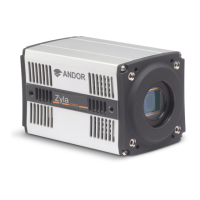version 2.0 rev 18 Feb 2021
16
Horizontal Scan Circuit
Vertical Scan Circuit
APS with column A/D
Photodiodes + Ampliers + Switches
SECTION 2: FEATURES AND FUNCTIONALITY
2.1 sCMOS Structure and Operation
sCMOStechnologyhasbeendevelopedspecicallytoovercomemanyofthelimitationsthathavemarred
otherscienticdetectortechnologies,resultinginanimagingdetectorthatprovidesexceptionalperformance
for many applications.
Figure 7: sCMOS Sensor Architecture
As illustrated above, the CMOS sensor is an “Active Pixel Sensor” (APS) whereby each pixel has its own integral
amplierandthesequenceofoperationisasfollows:
1. Light hits sensor and generates charge
2. Thephoto-generatedchargeisconvertedtoananalogvoltageinsideeachpixelamplier
3. Pixel voltage is transferred to the column bus via a row select signal
4. The analog voltage is then converted to a digital signal via columns of A/D (analog to digital) converters.
5. Thenaldigitizedsignalsarethenreadoutsequentiallyatapixelreadoutspeedofupto280MHz
fortheZyla5.5and270MHzfortheZyla4.2(inx2halves).
NOTES:
The diagram, above is representative- the light sensitive area is contiguous as the photodiodes for each
pixel are buried within the sensor. Each pixel also has a microlens to maximize sensitivity to light.
For Rolling Shutter mode operation, pixels in each row are exposed and the charge converted to a voltage
simultaneously before being digitized then read out sequentially
For Global Shutter mode, each pixel in the sensor begins an exposure simultaneously and then ends this
exposure simultaneously
1
2
3
4
5

